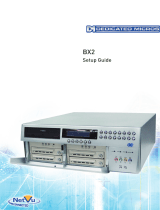
CONTENTS
Preface ....................................................................... 4
About the user manuals ......................................... 4
System requirements for a PC ............................... 4
Trademarks and registered trademarks ................. 5
Abbreviations ......................................................... 5
Restrictions when using this product ..................... 6
Before using this product ........................................... 7
Face matching function .......................................... 7
Motion detection (VMD) function ........................... 7
Time display of recorded images ........................... 7
Response to the mouse operations ....................... 7
Black screen displayed when playing recorded
images .................................................................... 8
Recording operation ............................................... 8
Event type .............................................................. 8
Use an SD memory card ............................................ 9
Operation window .................................................... 11
Ctrl (control) screen display .................................. 11
Live monitor (monitor for display of live images
only) ...................................................................... 15
Basic operation ........................................................ 16
Display the setup menu ........................................ 17
Logout .................................................................. 17
Login operation at startup ........................................ 18
Monitor live images .................................................. 19
Operation panel .................................................... 19
1-screen display (control screen only) .................. 20
Display camera images on a full screen
(wide view) ............................................................ 21
Display or hide the camera title ............................ 24
Use digital zoom (control screen only) ................. 24
Record images ......................................................... 25
Record images (schedule recording) .................... 25
Play recorded images ............................................... 26
Playback operation panel ..................................... 26
Play images from a designated point ....................... 28
Play image recorded at a designated
date & time ........................................................... 28
Play the latest recorded image ............................. 29
Playback by designating a timeline ...................... 30
Search and play ........................................................ 32
Play images selected from logs (log search) ........ 32
Search and play recorded images triggered by
motion detection (VMD search) ............................ 33
Play back copied images ......................................... 36
Event function .......................................................... 37
Event action .......................................................... 37
Stop buzzer beeping ............................................ 38
Cancel the alarm action ....................................... 39
Cancel the error action ......................................... 39
Copy recorded images ............................................. 40
Format SD memory card ...................................... 44
About the face matching function ............................ 45
Face matching alarm actions ............................... 45
Reset face matching alarm ................................. 46
Display the face matching thumbnail again ......... 46
Start/stop face matching actions manually .......... 47
Operate the camera ................................................. 48
Camera control panel ........................................... 48
Panning/Tilting ..................................................... 49
Zooming ............................................................... 50
Move to home position ........................................ 50
Focus adjustment ................................................. 50
Iris (brightness) adjustment .................................. 51
Auto mode ............................................................ 51
Register camera preset positions ........................ 52
Move camera preset positions ............................. 52
Register home position ........................................ 53
Execute auto back focus ...................................... 53
Set up mask areas ................................................ 54
Configure the network settings ................................ 55
Configure the network settings of the recorder.... 55
Configure the network settings of the PC ............ 55
Network security of the recorder .............................. 58
The security function of the recorder ................... 58
Enhance network security .................................... 58
Display the operation window .................................. 60
About the operation window .................................... 61
Top Page .............................................................. 61
Control panel ........................................................ 62
Camera selection panel ........................................ 63
Setup panel .......................................................... 64
Status display area ............................................... 65
Download operation area ..................................... 66
[CAM] tab ............................................................. 66
[HDD] tab .............................................................. 67
Monitor live images from cameras ........................... 68
Display images on a 1-screen .............................. 68
Display images on a 4-screen (multiscreen) ......... 69
Play recorded images ............................................... 70
Play image recorded at a designated date & time ... 72
Search and play recording events
(REC event search) ................................................... 73
Motion detection search and playback
(VMD search) ............................................................ 75
Check a list of copied recorded images ................... 77
Event function .......................................................... 79
Event action .......................................................... 79
Cancel the alarm action ....................................... 80
Cancel the error action ......................................... 80
Copy recorded images ............................................. 81
Download recorded images
currently being played .............................................. 83




















